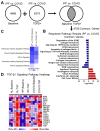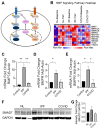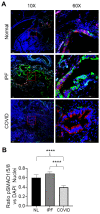Differential Transcriptomic Signatures of Small Airway Cell Cultures Derived from IPF and COVID-19-Induced Exacerbation of Interstitial Lung Disease
- PMID: 37887346
- PMCID: PMC10605205
- DOI: 10.3390/cells12202501
Differential Transcriptomic Signatures of Small Airway Cell Cultures Derived from IPF and COVID-19-Induced Exacerbation of Interstitial Lung Disease
Abstract
Idiopathic pulmonary fibrosis (IPF) is a pathological condition wherein lung injury precipitates the deposition of scar tissue, ultimately leading to a decline in pulmonary function. Existing research indicates a notable exacerbation in the clinical prognosis of IPF patients following infection with COVID-19. This investigation employed bulk RNA-sequencing methodologies to describe the transcriptomic profiles of small airway cell cultures derived from IPF and post-COVID fibrosis patients. Differential gene expression analysis unveiled heightened activation of pathways associated with microtubule assembly and interferon signaling in IPF cell cultures. Conversely, post-COVID fibrosis cell cultures exhibited distinctive characteristics, including the upregulation of pathways linked to extracellular matrix remodeling, immune system response, and TGF-β1 signaling. Notably, BMP signaling levels were elevated in cell cultures derived from IPF patients compared to non-IPF control and post-COVID fibrosis samples. These findings underscore the molecular distinctions between IPF and post-COVID fibrosis, particularly in the context of signaling pathways associated with each condition. A better understanding of the underlying molecular mechanisms holds the promise of identifying potential therapeutic targets for future interventions in these diseases.
Keywords: COVID-19; ILD; IPF; RNA-sequencing; TGF-β1; coronavirus; idiopathic pulmonary fibrosis; interstitial lung disease.
Conflict of interest statement
The authors declare there are no conflict of interest.
Figures







References
-
- Blackwell T.S., Tager A.M., Borok Z., Moore B.B., Schwartz D.A., Anstrom K.J., Bar-Joseph Z., Bitterman P., Blackburn M.R., Bradford W., et al. Future Directions in Idiopathic Pulmonary Fibrosis Research. An NHLBI Workshop Report. Am. J. Respir. Crit. Care Med. 2014;189:214–222. doi: 10.1164/rccm.201306-1141WS. - DOI - PMC - PubMed
-
- Stancil I.T., Michalski J.E., Davis-Hall D., Chu H.W., Park J.A., Magin C.M., Yang I.V., Smith B.J., Dobrinskikh E., Schwartz D.A. Pulmonary fibrosis distal airway epithelia are dynamically and structurally dysfunctional. Nat. Commun. 2021;12:4566. doi: 10.1038/s41467-021-24853-8. - DOI - PMC - PubMed
-
- Verleden S.E., Tanabe N., McDonough J.E., Vasilescu D.M., Xu F., Wuyts W.A., Piloni D., De Sadeleer L., Willems S., Mai C., et al. Small airways pathology in idiopathic pulmonary fibrosis: A retrospective cohort study. Lancet Respir. Med. 2020;8:573–584. doi: 10.1016/S2213-2600(19)30356-X. - DOI - PMC - PubMed
-
- Abdelgied M., Uhl K., Chen O.G., Schultz C., Tripp K., Peraino A.M., Paithankar S., Chen B., Tamae Kakazu M., Castillo Bahena A., et al. Targeting ATP12A, a Non-Gastric Proton Pump Alpha Subunit, for Idiopathic Pulmonary Fibrosis Treatment. Am. J. Respir. Cell Mol. Biol. 2023;68:638–650. doi: 10.1165/rcmb.2022-0264OC. - DOI - PMC - PubMed
Publication types
MeSH terms
Grants and funding
LinkOut - more resources
Full Text Sources
Medical
Molecular Biology Databases

